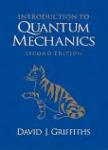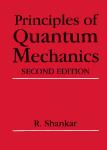Автор: Griffiths D.
Теги: mechanics
Текст
Corrections ф 1, August 15, 2004
Introduction to Quantum Mechanics, 2nd ed.
by David Griffiths
• page 40, Problem 2.9: remove ", using Equation 2.39"; capitalize "Be-
"Because" .
• page 49: put a box around Eq. 2.69.
• page 72, Eq. 2.124: change middle term (after "=") to read:
• page 78, Eq. 2.145: change "<" to "<" (twice) in the top line.
• page 92, Problem 2.54: remove "[" before "NDSolve".
• page 96, Problem 3.2(b): change "in Hubert" to "in this Hilbert".
• page 124, Problem 3.23: remove "(normalized)", and change "E" to "e"
(twice).
• page 125, Problem 3.30: after the equation, on the same line, insert
"(—oo < x < oo)".
• page 128, Problem 3.37: after "are real numbers" insert "(assume a — c/
• page 141, Eq. 4.40: change "<" to "<" in the top line.
• page 142, 6 lines up from bottom: change "~" to "=" (twice).
• page 154, Table 4.7: the third "a" in "Д21" should be math italic, not
Roman.
• page 199, Problem 4.60: give it three stars (instead of just two); in part
(b), remove "stationary states and the".
• page 218, Problem 5.13(a): change "all other things being equal" to "con-
"consistent with the Pauli principle".
• page 229, Problem 5.20: change second sentence on to read as follows:
Analyze this case, constructing the analog to Figure 5.6. This
requires no new calculation, for the positive energy solutions
(except that /3 is now negative; use /3 = —1.5 for the graph),
but you do need to work out the negative energy solutions (let
к = \/—2mE/h and z = —ка, for E < 0). How many states are
there in the first allowed band?
• page 246, Problem 5.35(c): at the very end insert the letter "m".
• page 247, Problem 5.36(b), line 7: change .4" to .04".
• page 285, Problem 6.28, line 9: change .85" to .82".
• page 287, Eq. 6.97: switch the signs of x\ and x2 (four times); Eq. 6.99
(twice), Eq. 6.101, line before Eq. 6.102, and Eq. 6.102: change 4тгб0 to
2тгб0.
• pages 353-354, 3 lines above Eq. 9.45-Eq. 9.46: Change this paragraph to
read as follows:
The averaging can be carried out as follows: Choose spher-
spherical coordinates such that the direction of propagation (fc) is
along x, the polarization (n) is along z, and the vector p de-
defines the spherical angles в and ф (Figure 9.5).12 (Actually, p is
fixed here, and we're averaging over all к and n consistent with
к JL п—which is to say, over all в and ф. But it's really the
coordinate system, not the vector p, that is changing.) Then
p - n = pcosO,
and
= it / |
4тг J
cos2 <9 sin
IH
\
4тг
• page 354, Figure 9.5: Modify as follows:
B7Г) = \\p\2. [9.46]
• page 365, Problem 9.20(c): change the first two lines to read: "Check that
the general solution for a(t) and 6(t), in terms of their initial values a$
and 60, is".
• page 391, Problem 10.8(c): change "show that it" to "show that the small-
smallest z".
• page 393, Problem 10.10(b): remove the first г in both equations, and
replace it with a minus sign in the first equation (only).
• page 403, Eq. 11.33: remove the minus sign.
• page 419: add new problem, as follows:
Problem 11.20 Use the Born approximation to determine the
total cross-section for scattering from a gaussian potential
V(r) =Ae~^r\
Express your answer in terms of the constants Д /i, and m (the
mass of the incident particle), and к = л/2тЕ/Н, where E is
the incident energy.
• page 432, Eq. 12.20: the subscript should be ", not ".
• page 446, Problem A.8: eliminate part (g) and relabel the others ac-
accordingly. Problem A. 11: insert "necessarily" between "matrices" and
"unitary".
• page 447, the two centered equations following Eq. A.63: change ae to a/e
(twice) and a?' to a .
• page 467, "trace": change 47" to 48".






